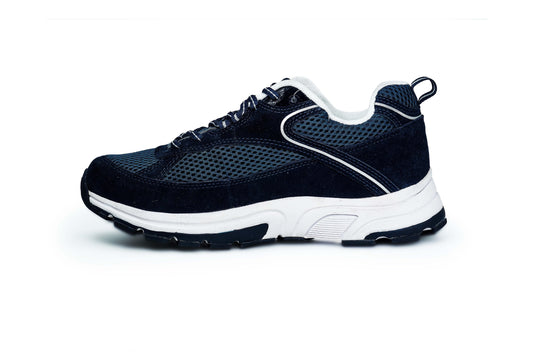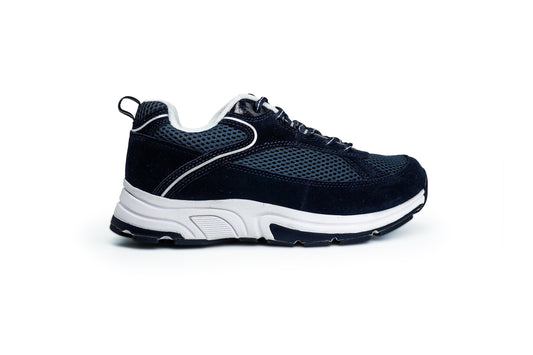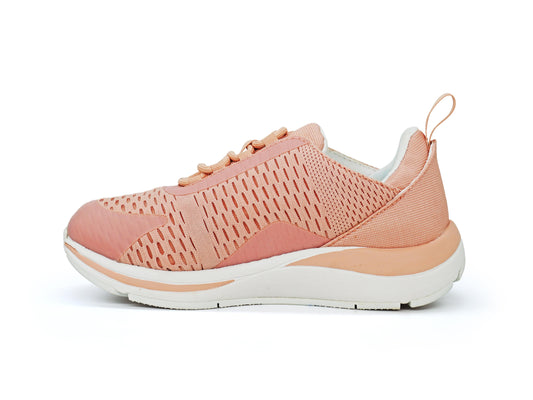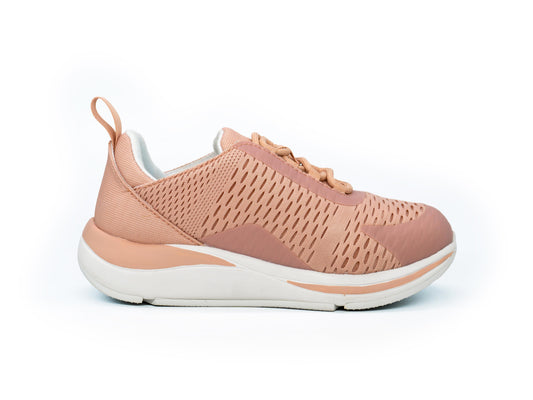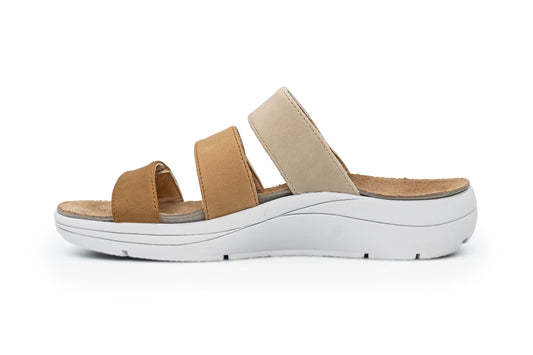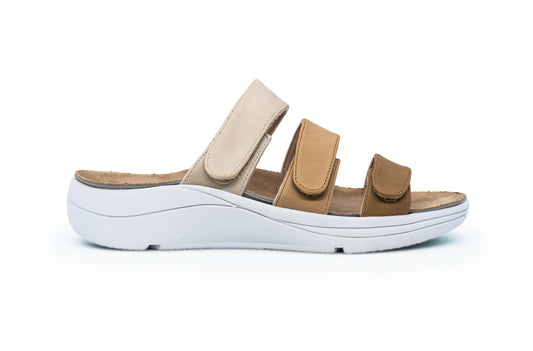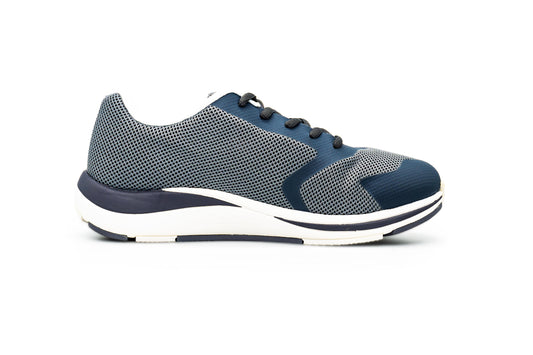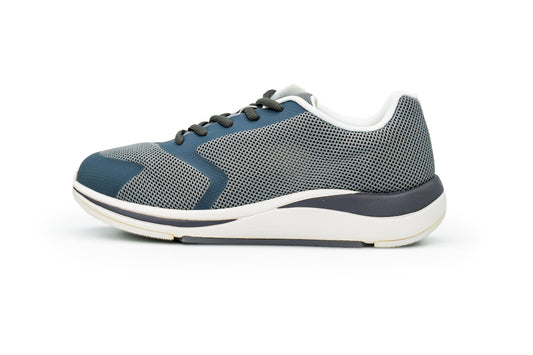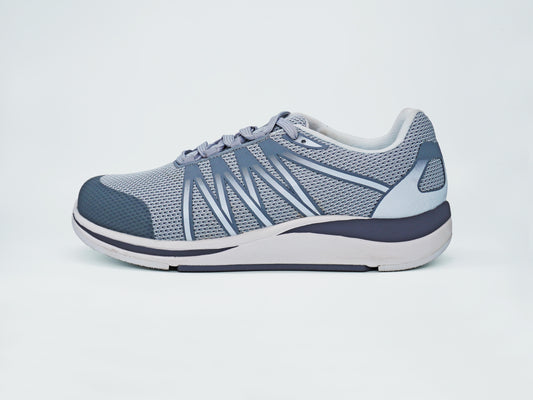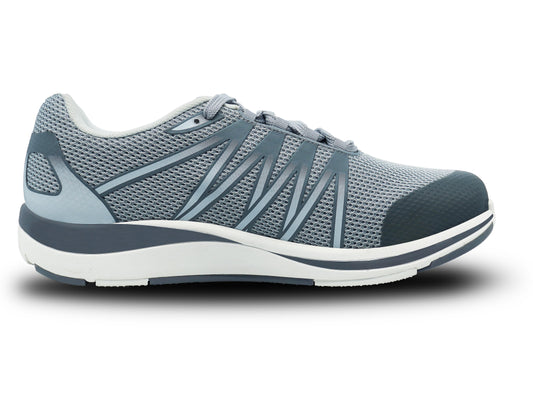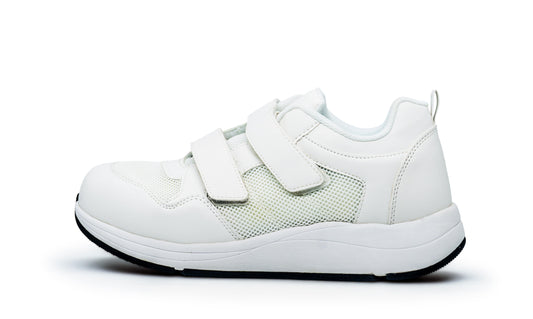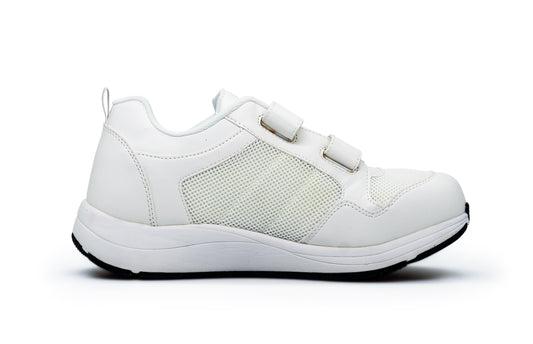-
Vendor: MENS
AARON Diabetic & Orthopedic Athletic Shoes - Mens - Navy Suede/Mesh
Walk in confidence knowing Drew Aaron only available exclusive at DiabeticShoe.in offers the proprietary Plus Fitting System® with two removable insoles plus all the therapeutic benefits Drew is famous for. With shock-absorbing inserts, flared outsoles, firm heel counters and Drilex® linings to wick away...- ₹ 11,695
₹ 12,995- ₹ 11,695
- Unit price
- / per
-
Navy Suede/Mesh
-
Vendor: MENS
STABLE Diabetic & Orthopedic Walking Shoes - Mens - Grey Mesh
The name says it all. The Stable features our proprietary Drew with Walk Right Technology™ in a men's athletic sneaker/walking shoe with superior support and comfort. A slip-resistant outsole will keep you connected with the ground. The high rebound EVA midsole provides shock absorption...- ₹ 10,795
₹ 11,995- ₹ 10,795
- Unit price
- / per
-
Grey Mesh
-
Vendor: MENS
PLAYER Diabetic & Orthopedic Athletic Shoes - Mens - Grey Mesh
The men's Player offers Drew with Walk Right Technology™ and is engineered for protection and superior comfort and support only avaiable to buy at Diabetic Shoe India. A slip-resistant outsole will keep you on your feet. The high rebound EVA midsole provides shock absorption...- ₹ 10,795
₹ 11,995- ₹ 10,795
- Unit price
- / per
-
Grey Mesh
-
Vendor: MENS
CONTEST Diabetic & Orthopedic Sneaker- Mens - White Combo
The Contest by Drew men's double hook and loop sneaker is engineered for superior comfort exclusively available to buy from Diabetic Shoe India. A slip-resistant outsole will keep you sure on your feet. The high rebound EVA midsole provides shock absorption to reduce foot...- ₹ 10,795
₹ 11,995- ₹ 10,795
- Unit price
- / per
-
White Combo
Trending Now
Popular Products
Vendor:
MENS
AARON Diabetic & Orthopedic Athletic Shoes - Mens - Navy Suede/Mesh
Walk in confidence knowing Drew Aaron only available exclusive at DiabeticShoe.in offers the proprietary Plus Fitting System® with two removable insoles plus all the therapeutic benefits Drew is famous for. With shock-absorbing inserts, flared outsoles, firm heel counters and Drilex® linings to wick away...
- ₹ 11,695
₹ 12,995- ₹ 11,695
- Unit price
- / per
-
Navy Suede/Mesh
Vendor:
WOMENS
SPRINTER Diabetic & Orthopedic Athletic Shoe Rose - Womens - Rose Combo
The Sprinter women's lace-up sneaker by Drew only available exclusively at Diabeticshoe.in features our Walk Right Technology Insole and is engineered for protection and superior comfort. A slip-resistant outsole will keep you on your feet. The high rebound EVA midsole provides shock absorption to...
- ₹ 11,695
₹ 12,995- ₹ 11,695
- Unit price
- / per
-
Rose Combo
-
Grey Mesh Combo
Vendor:
WOMENS
SAWYER Diabetic & Orthopedic Sandal - Womens - Blue Combo
Sawyer womens sandals by Drew® at DiabeticShoe.in combine an updated modern look with a hard-to-find removable insole. The removable Walk Right Technology™ footbed makes Sawyer one of the most comfortable women's sandals around! Featuring a lightweight outsole and three hook and loop adjustable straps,...
- ₹ 8,995
₹ 10,995- ₹ 8,995
- Unit price
- / per
-
Blue Combo
-
Natural Combo
Mens Diabetic Athletic Footwear
Elevate your running experience with DiabeticShoe.in's exclusive collection of Men's Running Orthotics. More than just shoes, this carefully curated range is tailored for men seeking the perfect fusion of foot health and high-performance design. Precision-engineered and crafted from premium materials, each pair ensures optimal well-being, redefining expectations for running orthotics.
Immerse yourself in the seamless blend of therapeutic benefits and functional design. From advanced cushioning that cradles your feet to targeted support in crucial areas, our Men's Running Orthotics provide an unparalleled combination of comfort and performance. Trust us to offer more than just shoes; we provide a holistic experience tailored for men prioritizing both foot health and an active lifestyle.
Explore our curated collection at DiabeticShoe.in and confidently step into a world where comfort and mobility coalesce seamlessly. Enhance your understanding of foot health through insightful blogs, such as the Diabetic Footwear Research Centre and Orthopedic Footwear Research Centre.
DiabeticShoe.in is the exclusive dealer of Drew Orthotics, a well-known American-prescribed orthotics brand.
Sidebar
Why Choose Orthopedic & Diabetic Shoes?
Orthopedic & diabetic shoes combine soft, seamless interiors with supportive orthotic technology to protect sensitive feet from blisters, pressure, and friction. With added depth, cushioned soles, and a roomy fit, these shoes provide relief while helping to prevent foot conditions commonly associated with diabetes.
Key Features:
- Seam-Free, Padded Interiors: Each shoe is designed with a seamless lining and extra padding to prevent irritation and friction, making them ideal for individuals with sensitive feet or neuropathy.
- Orthotic Insoles with Arch Support: Built-in orthotic insoles provide gentle arch support and improve foot alignment, helping to alleviate pain from common foot issues like plantar fasciitis and flat feet.
- Lightweight, Shock-Absorbing Soles: The cushioned soles absorb impact with each step, reducing pressure on the feet, knees, and lower back. This feature is especially beneficial for individuals with diabetes, as it helps prevent undue stress on the feet.
- Wide Toe Box and Extra Depth: Designed with a spacious toe box, Orthopedic & diabetic shoes allow natural toe movement and accommodate swollen feet or foot deformities, providing a comfortable, pressure-free fit.
- Adjustable Fit Options: Many styles feature adjustable closures, such as Velcro straps or laces, allowing for a personalized fit that accommodates swelling and provides extra stability.
- Reinforced arch support: Insoles are designed to support the arch, maintain proper foot alignment, and relieve pressure on joints.
- Firm heel counter: A stiff, supportive back section prevents the heel from sliding around in the shoe, which adds stability and motion control.
- Durable construction: These shoes are built to be sturdy and provide long-lasting support to the foot's structure.
- Soft, non-binding materials: The shoe's uppers are made from soft, flexible, and often stretchy materials that conform to the foot's contours and prevent constriction, which is important for circulation
- Breathable materials: Fabrics like leather and mesh promote air circulation, keeping the feet dry and reducing the risk of fungal infections.
- Protective, non-skid sole: The sturdy outsole shields the foot from sharp objects, and the non-slip design reduces the risk of falls.
- Adjustable straps: Hook-and-loop (Velcro) straps or laces allow for easy adjustments to accommodate fluctuations in foot swelling throughout the day
Benefits of Orthopedic & Diabetic Shoes:
Both orthopedic and diabetic shoes are therapeutic footwear designed to protecy and support the feet, but they serve different primary purposes. Orthopedic shoes correct biomechanical foot issues, while diabetic shoes are specifically engineered to prevent complications in diabetic patients who are prone to foot injuries and ulcers.
- Enhanced Foot Protection: Soft, seamless interiors and cushioned support protect sensitive feet from blisters, pressure, and irritation, promoting better foot health.
- Pain Relief and Stability: Orthotic insoles and ergonomic design provide the support needed to alleviate pain and ensure stability, reducing the risk of slips and falls.
- Long-Lasting Comfort: With shock-absorbing materials and a comfortable, supportive fit, Orthopedic & diabetic shoes offer the all-day comfort you need to stay active and pain-free.
- Improve support and alignment: They feature reinforced arch support, firm heel counters, and cushioned insoles that help maintain proper alignment of the feet and ankles. This also helps with issues like flat feet and high arches.
- Reduce pain: Orthopedic footwear is effective at relieving foot pain caused by conditions like plantar fasciitis, heel spurs, bunions, and arthritis. The extra cushioning helps absorb shock and minimizes pressure on sensitive areas.
- Enhance mobility: By providing stability and support, these shoes make it easier and more comfortable to walk, stand, and move. This is especially beneficial for those with arthritis, injuries, or other conditions that affect gait.
- Accommodate foot deformities: Features like wide toe boxes reduce friction and pressure on bunions and hammertoes, preventing discomfort and the condition from worsening.
- Distribute pressure: The design ensures that weight is evenly distributed across the foot, which reduces stress on joints and other key areas.
- Improve overall posture: By promoting better foot and ankle alignment, orthopedic shoes can have a positive effect on your posture, which in turn can relieve pain in the knees, hips, and back.
- Prevent foot ulcers: Diabetes can cause nerve damage that reduces sensation in the feet. A minor cut or blister can go unnoticed and develop into an ulcer. Diabetic shoes have seamless interiors and soft, non-binding uppers to eliminate friction and pressure points that can lead to skin breakdown and ulcers.
- Protect against injury: Stiff toe boxes and durable construction shield feet from accidental bumps or impacts, which is crucial for those with reduced sensation who might not feel an injury.
- Enhance circulation: Designed with extra depth and wide toe boxes, diabetic shoes promote healthy blood flow by preventing constriction. The reduced pressure on the feet helps improve circulation, which is often poor in individuals with diabetes.
- Accommodate foot deformities and swelling: The roomy design provides space for common diabetes-related foot changes, such as swelling, bunions, and hammertoes. Adjustable closures can accommodate daily fluctuations in foot size.
- Reduce risk of amputation: By preventing and managing foot injuries and infections, proper therapeutic footwear is a critical tool for reducing the risk of amputation associated with severe diabetic foot complications.
- Ensure optimal foot health: Regular use of diabetic shoes, along with daily foot checks and hygiene, is a key part of a comprehensive foot care plan for diabetics, leading to enhanced mobility and independence.
Ideal for Everyday Activities and Long Hours
Orthopedic & diabetic shoes are crafted to support you through any daily activity, from work to casual outings:
- Home and Daily Wear: Perfect for relaxing or light walking, these shoes keep your feet cushioned and comfortable all day.
- Errands and Social Outings: With a stylish yet practical design, Orthopedic & diabetic shoes allow you to stay active and look great without compromising on foot health.
- Protect your feet with Orthoshoes diabetic shoes, designed to provide gentle, reliable support and comfort for sensitive feet. Discover footwear that’s as protective as it is comfortable.
Shop the collection today and step into comfort and peace of mind!
FAQs
What makes athletic footwear "diabetic-friendly"?
Seamless interior: A soft, smooth lining reduces friction and irritation that could otherwise lead to blisters or sores.
Extra depth: Additional space inside the shoe accommodates custom orthotics or special inserts for personalized support.
Wide, deep toe box: The roomy front area prevents pressure on the toes, which helps with foot deformities like bunions and hammertoes.
Cushioned, shock-absorbing soles: The insoles and outsoles absorb impact from walking and running, which reduces stress on foot joints and tissues.
When should a man with diabetes consider wearing special athletic footwear?
Neuropathy (nerve damage): Reduced sensation in the feet means you may not notice injuries or pressure spots from ill-fitting shoes.
Poor circulation: Reduced blood flow can cause wounds to heal more slowly and increase the risk of infection.
Foot deformities: Conditions like bunions, hammertoes, or Charcot foot require a roomy, accommodating shoe.
History of foot ulcers or calluses: These are signs of high-pressure areas that need specialized support to prevent re-injury.
How do I ensure I get the correct fit?
Get a professional measurement: Have your feet measured for length and width by a specialist, as foot size can change over time.
Shop in the afternoon: Feet typically swell during the day, so trying on shoes later will ensure a comfortable fit even when your feet are at their largest.
Check the fit with socks: Always try on shoes with the diabetic socks you plan to wear.
What kind of socks should I wear with diabetic shoes?
Seamless: Socks without seams reduce friction and the risk of blisters.
Moisture-wicking: Special moisture-wicking materials help keep feet dry and reduce the risk of infection.
Non-binding: Look for socks that do not have tight, restrictive elastic at the top, which can impair circulation.
How often should I replace my diabetic athletic shoes?
Signs of wear – Check your shoes regularly for signs of wear and tear. Look for worn-out soles, frayed seams, or flattened cushioning.
Loss of support – If your shoes aren’t providing the support and cushioning they once did, it's time to get a replacement.
Change in fit – Both your feet and shoes can change over time. If your shoes become too tight, loose, or uncomfortable it could be time for a new pair.
Should men with diabetes avoid regular athletic shoes?
Yes, for men with diabetes, especially those with neuropathy or poor circulation, regular athletic shoes are generally not recommended. Unlike diabetic athletic shoes, standard sneakers often have interior seams, rough stitching, and a more restrictive fit that can cause friction, pressure, and unnoticed blisters. Since nerve damage can mask foot injuries, these small problems can escalate into severe ulcers and infections, so specialized footwear is crucial for protecting sensitive feet and preventing serious complications.
Can I use my custom orthotics in diabetic athletic shoes?
Yes, many diabetic athletic shoes are specifically designed with removable insoles to accommodate custom orthotics. This feature allows for the seamless integration of personalized arch support and cushioning, which can be essential for those with specific foot conditions or deformities. The combination of a professionally-fitted diabetic shoe and custom orthotics provides enhanced support and protection, maximizing comfort while reducing pressure points.
What is the best way to care for and clean diabetic athletic shoes?
To care for diabetic athletic shoes, clean them regularly with a damp cloth and mild soap, then allow them to air-dry completely away from direct heat. To prevent odor and bacterial buildup, remove and clean the insoles periodically. Proper drying is crucial, as moisture trapped in shoes can lead to fungal infections. Regular maintenance and inspecting for any signs of wear, such as worn-down cushioning or damage, will ensure the shoes continue to provide optimal protection.
Where can these shoes be purchased?
They can be purchased directly and customised for your needs on our website. They are available in various designs suited for everyone.
Recently Viewed Products
- Choosing a selection results in a full page refresh.

